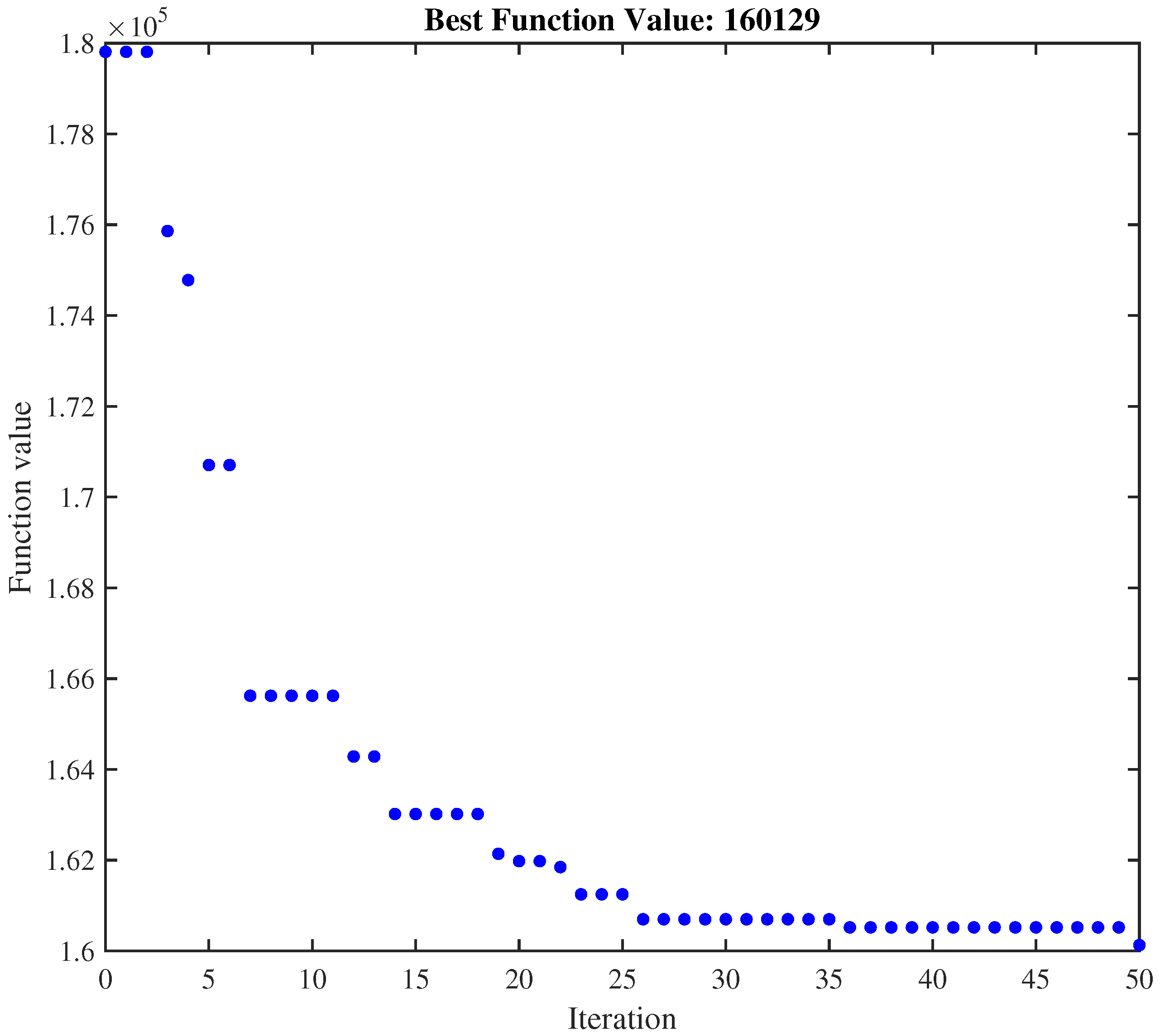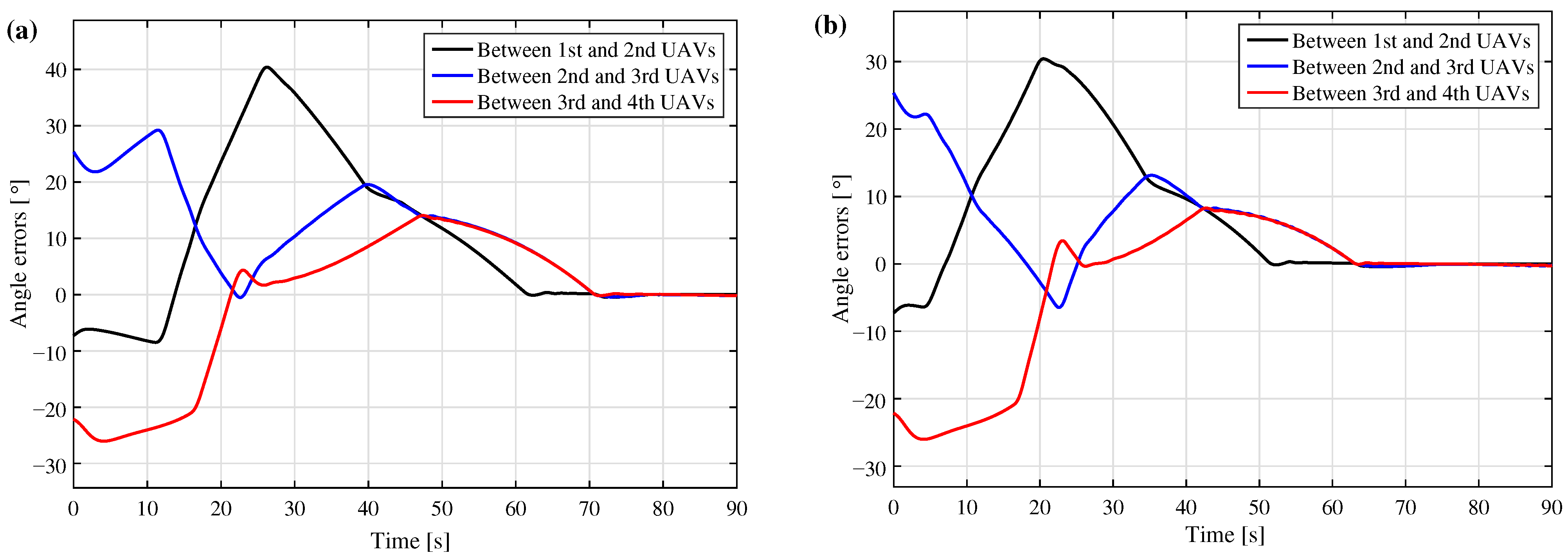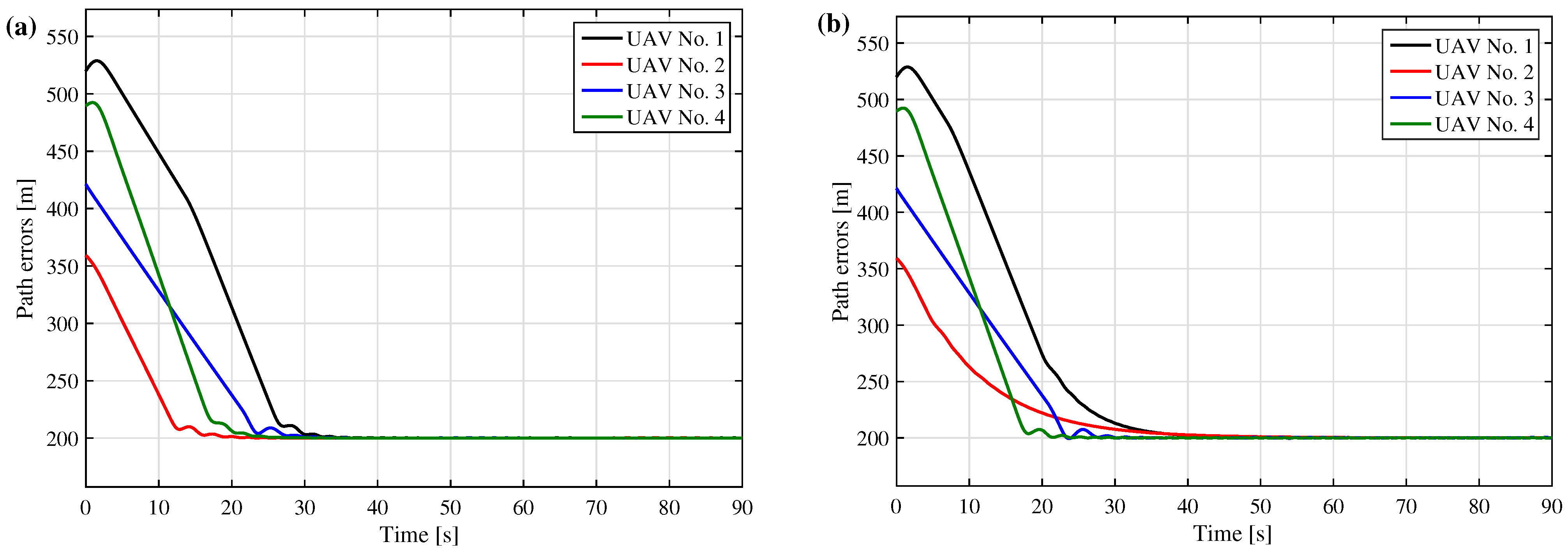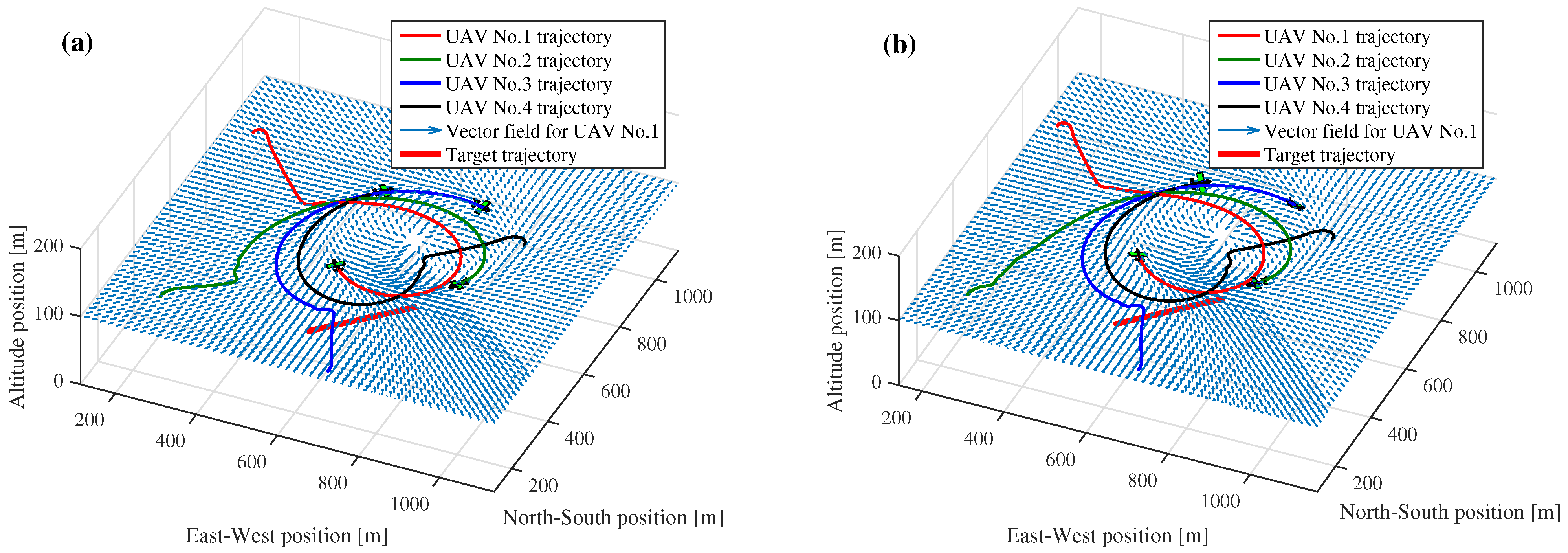Particle Swarm Optimization for Target Encirclement by a UAV Formation †
Abstract
1. Introduction
2. Preliminary Remarks and Statement of Problem
3. Consensus-Based UAV Formation Control Algorithm
4. Implementation of Particle Swarm Optimization
5. Simulation Results
5.1. Simulation Parameters
5.2. Simulation Results and Discussion
6. Conclusions
Funding
Institutional Review Board Statement
Informed Consent Statement
Data Availability Statement
Conflicts of Interest
References
- Darintsev, O.V.; Yudintsev, B.S.; Alekseev, A.Y.; Bogdanov, D.R.; Migranov, A.B. Methods of a Heterogeneous Multi-agent Robotic System Group Control. Procedia Comput. Sci. 2019, 150, 687–694. [Google Scholar] [CrossRef]
- Ivanov, D.Y. Distribution of roles in groups of robots with limited communications based on the swarm interaction. Procedia Comput. Sci. 2019, 150, 518–523. [Google Scholar] [CrossRef]
- Veselov, G.; Sklyrov, A.; Mushenko, A.; Sklyrov, S. Synergetic Control of a Mobile Robot Group. In Proceedings of the 2014 2nd International Conference on Artificial Intelligence, Modelling and Simulation, Madrid, Spain, 18–20 November 2014; pp. 155–160. [Google Scholar] [CrossRef]
- Bennet, D.J.; McInnes, C.R.; Suzuki, M.; Uchiyama, K. Autonomous Three-Dimensional Formation Flight for a Swarm of Unmanned Aerial Vehicles. J. Guid. Control Dyn. 2011, 34, 1899–1908. [Google Scholar] [CrossRef]
- Milyakov, D.A.; Merkulov, V.I. The Approach to Managing a Group of UAVs as a System with Distributed Parameters. Procedia Comput. Sci. 2019, 150, 39–45. [Google Scholar] [CrossRef]
- Diveev, A.I.; Shmalko, E.Y.; Hussein, O. Synthesized Optimal Control of Group Interaction of Quadrocopters Based on Multi-Point Stabilization. Instrum. Eng. 2020, 133, 114–133. [Google Scholar] [CrossRef]
- Titkov, I.P.; Karpunin, A. Collision-aware formation assignment of quadrotors. Procedia Comput. Sci. 2021, 186, 727–735. [Google Scholar] [CrossRef]
- Pavlovskii, V.E.; Pavlovskii, V.V. A mathematical model of a 2D homogeneous swarm of robots. Sci. Tech. Inf. Process. 2016, 43, 306–314. [Google Scholar] [CrossRef]
- Senotov, V.D.; Aliseychik, A.P.; Pavlovsky, E.V.; Podoprosvetov, A.V.; Orlov, I.A. Algorithms for swarm decentralized motion control of group of robots with a differential drive. Keldysh Inst. Prepr. 2020, 123, 1–39. [Google Scholar] [CrossRef]
- Zakiev, A.; Tsoy, T.; Magid, E. Swarm robotics: Remarks on terminology and classification. In Proceedings of the Interactive Collaborative Robotics: Third International Conference, ICR 2018, Leipzig, Germany, 18–22 September 2018; pp. 291–300. [Google Scholar]
- Ollervides-Vazquez, E.J.; Rojo-Rodriguez, E.G.; Garcia-Salazar, O.; Amezquita-Brooks, L.; Castillo, P.; Santibañez, V. A sectorial fuzzy consensus algorithm for the formation flight of multiple quadrotor unmanned aerial vehicles. Int. J. Micro Air Veh. 2020, 12, 1756829320973579. [Google Scholar] [CrossRef]
- Muslimov, T.Z.; Munasypov, R.A. Multi-UAV cooperative target tracking via consensus-based guidance vector fields and fuzzy MRAC. Aircr. Eng. Aerosp. Technol. 2021, 93, 1204–1212. [Google Scholar] [CrossRef]
- Diveev, A.; Shmalko, E. Hybrid evolutionary algorithm for synthesized optimal control problem for group of interacting robots. In Proceedings of the 2019 6th International Conference on Control, Decision and Information Technologies (CoDIT), Paris, France, 23–26 April 2019; pp. 876–881. [Google Scholar] [CrossRef]
- Bożko, A.; Ambroziak, L.; Pawluszewicz, E. Genetic Algorithm for Parameters Tuning of Two Stage Switching Controller for UAV Autonomous Formation Flight. Adv. Intell. Syst. Comput. 2021, 1390, 154–165. [Google Scholar]
- Kim, M. Error Dynamics-Based Guidance Law for Target Observation using Multiple UAVs with Phase Angle Constraints via Evolutionary Algorithms. J. Control Autom. Electr. Syst. 2021, 32, 1510–1520. [Google Scholar] [CrossRef]
- Ali, Z.A.; Zhangang, H. Multi-unmanned aerial vehicle swarm formation control using hybrid strategy. Trans. Inst. Meas. Control 2021, 43, 2689–2701. [Google Scholar] [CrossRef]
- Ali, Z.A.; Han, Z.; Masood, R.J. Collective Motion and Self-Organization of a Swarm of UAVs: A Cluster-Based Architecture. Sensors 2021, 21, 3820. [Google Scholar] [CrossRef] [PubMed]
- Derrouaoui, S.H.; Bouzid, Y.; Guiatni, M. PSO Based Optimal Gain Scheduling Backstepping Flight Controller Design for a Transformable Quadrotor. J. Intell. Robot. Syst. 2021, 102, 67. [Google Scholar] [CrossRef]
- Kiyak, E. Tuning of controller for an aircraft flight control system based on particle swarm optimization. Aircr. Eng. Aerosp. Technol. 2016, 88, 799–809. [Google Scholar] [CrossRef]
- Saribas, H.; Kahvecioglu, S. PSO and GA tuned conventional and fractional order PID controllers for quadrotor control. Aircr. Eng. Aerosp. Technol. 2021, 93, 1243–1253. [Google Scholar] [CrossRef]
- Biantoro, N.; Halim, M.; Nazaruddin, Y.Y.; Juliastuti, E. PSO-based Optimization of Formation Control and Obstacle Avoidance for Multiple Quadrotors. In Proceedings of the 2021 International Conference on Instrumentation, Control and Automation (ICA), Bandung, Indonesia, 25–27 August 2021; pp. 133–137. [Google Scholar] [CrossRef]
- Hoang, V.T.; Phung, M.D.; Dinh, T.H.; Zhu, Q.; Ha, Q.P. Reconfigurable Multi-UAV Formation Using Angle-Encoded PSO. In Proceedings of the 2019 IEEE 15th International Conference on Automation Science and Engineering (CASE), Vancouver, BC, Canada, 22–26 August 2019; pp. 1670–1675. [Google Scholar] [CrossRef]
- Sruthy, A.N.; Jacob, J.; Ramch, R. PSO Based Integral Backtepping Control for Leader-Follower Quadrotors. In Proceedings of the 2020 Fourth International Conference on Inventive Systems and Control (ICISC), Coimbatore, India, 8–10 January 2020; pp. 466–471. [Google Scholar] [CrossRef]
- Vijayakumari, D.M.; Kim, S.; Suk, J.; Mo, H. Receding-Horizon Trajectory Planning for Multiple UAVs Using Particle Swarm Optimization; AIAA Scitech 2019 Forum; American Institute of Aeronautics and Astronautics: Reston, VA, USA, 2019. [Google Scholar] [CrossRef]
- Patley, A.; Bhatt, A.; Maity, A.; Das, K.; Ranjan Kumar, S. Modified Particle Swarm Optimization Based Path Planning for Multi-Uav Formation; AIAA Scitech 2019 Forum; American Institute of Aeronautics and Astronautics: Reston, VA, USA, 2019. [Google Scholar] [CrossRef]
- Skrzypecki, S.; Tarapata, Z.; Pierzchała, D. Combined PSO Methods for UAVs Swarm Modelling and Simulation. In Proceedings of the Modelling and Simulation for Autonomous Systems: 6th International Conference, MESAS 2019, Palermo, Italy, 29–31 October 2019; pp. 11–25. [Google Scholar]
- Muslimov, T.Z.; Munasypov, R.A. Coordinated UAV Standoff Tracking of Moving Target Based on Lyapunov Vector Fields. In Proceedings of the 2020 International Conference Nonlinearity, Information and Robotics (NIR), Innopolis, Russia, 3–6 December 2020; pp. 1–5. [Google Scholar] [CrossRef]
- Muslimov, T. Application of Genetic Algorithm for Vector Field Guidance Optimization in a UAV Collective Circumnavigation Scenario. In Robotics in Natural Settings: CLAWAR 2022; Springer International Publishing: Cham, Switzerland, 2022. [Google Scholar]
- Beard, R.W.; McLain, T.W. Small Unmanned Aircraft: Theory and Practice; Princeton University Press: Princeton, NJ, USA, 2012. [Google Scholar]




| Parameter | Symbol | Values |
|---|---|---|
| Initial UAV heading vector (rad) | ||
| Initial UAV speed vector (m/s) | ||
| Circular path radius (m) | 200 | |
| Initial target coordinates (m) | ||
| Ultimate cruise speed of the formation in case of a stationary target (m/s) | v | 13 |
| Target speed (m/s) | 2 | |
| Target course angle (rad) | ||
| Vector of initial UAV coordinates in the ICS (m) | ||
| Desired inter-UAV phase shift angles | ||
| Initial tuning coefficients | 35, 15, 1, 2 |
Disclaimer/Publisher’s Note: The statements, opinions and data contained in all publications are solely those of the individual author(s) and contributor(s) and not of MDPI and/or the editor(s). MDPI and/or the editor(s) disclaim responsibility for any injury to people or property resulting from any ideas, methods, instructions or products referred to in the content. |
© 2023 by the author. Licensee MDPI, Basel, Switzerland. This article is an open access article distributed under the terms and conditions of the Creative Commons Attribution (CC BY) license (https://creativecommons.org/licenses/by/4.0/).
Share and Cite
Muslimov, T. Particle Swarm Optimization for Target Encirclement by a UAV Formation. Eng. Proc. 2023, 33, 15. https://doi.org/10.3390/engproc2023033015
Muslimov T. Particle Swarm Optimization for Target Encirclement by a UAV Formation. Engineering Proceedings. 2023; 33(1):15. https://doi.org/10.3390/engproc2023033015
Chicago/Turabian StyleMuslimov, Tagir. 2023. "Particle Swarm Optimization for Target Encirclement by a UAV Formation" Engineering Proceedings 33, no. 1: 15. https://doi.org/10.3390/engproc2023033015
APA StyleMuslimov, T. (2023). Particle Swarm Optimization for Target Encirclement by a UAV Formation. Engineering Proceedings, 33(1), 15. https://doi.org/10.3390/engproc2023033015






